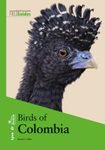Field / Identification Guide
By: Martyn Kenefick(Author), Robin L Restall(Author), Floyd Hayes(Author)
272 pages, 115 plates with colour illustrations; colour distribution maps
![Birds of Trinidad & Tobago Birds of Trinidad & Tobago]()
Click to have a closer look
About this book
Customer reviews
Biography
Related titles
About this book
Trinidad & Tobago are popular tourist destinations, and the islands are also a top location for visiting birders. This comprehensive and portable field guide covers every species found on the islands. The concise text includes descriptions of every species, highlighting plumage variation and distinctions from similar species.
The third edition has been revised, with many images being repainted. The text has also been updated, and has been written specifically to assist in the field identification of every species that occurs on Trinidad & Tobago. This new edition supersedes all previous field guides to these popular islands.
Customer Reviews
Biography
Martyn Kenefick lives in Trinidad where he is a professional bird guide. Robin Restall is the illustrator of Birds of Northern South America and until recently lived in Venezuela before retiring to Norfolk. Floyd Hayes is an American ornithologist who formerly taught at the University of the West Indies on Trinidad.
Field / Identification Guide
By: Martyn Kenefick(Author), Robin L Restall(Author), Floyd Hayes(Author)
272 pages, 115 plates with colour illustrations; colour distribution maps
"This third edition of the guide to one of the most popular places for wintering birds in the Caribbean is significantly updated, with superb illustrations, many of them new, and text. The coverage is extremely comprehensive [...]"
– Ibis, 2020
Customer Reviews:
Birds of Trinidad and Tobago
by Keith Betton in the United Kingdom (24/01/2012)
Trinidad and Tobago jointly provide a fantastic destination for a birding holiday, particularly in winter. Their avifauna is in fact allied to South America, with the south-west tip of Trinidad being just 8 miles from Venezuela. It is about the same size as the county of Kent, while Tobago would fit into that 16 times. Their bird lists reflect this difference. Putting rarities aside, about 106 species regularly occur on both islands, but a further 157 are mainly found on Trinidad and 20 are generally restricted to Tobago.
This is the second edition of the book which first appeared in 2007. If you have that first edition then you probably don't need to buy a new copy, but for first-time buyers, this is the edition to look for as it includes better illustrations and updated text.
In typical field guide style the colour plates on the right-hand page are clearly annotated, feature around five species and face text on the left page. Some of Robin Restall's excellent illustrations have been taken directly from his hefty two-volume Birds of Northern South America but others have been newly created for this second edition. In the 2007 version some of the plates were poorly laid out with too much empty space, while others were crowded. Good examples of where the design has been vastly improved are the owls and nightjars. There are also many improved illustrations, and groups such as the flycatchers are much more pleasing than before. Some of the changes seem to be unnecessary – such as now illustrating all the ducks on water instead of land. An extra 16 pages have helped to allow eight more plates to be included.
The text has been updated by Martyn Kenefick and Floyd Hayes and provides information on plumage, voice, similar species and status. The book is very thorough and all 471 species on the Trinidad and Tobago list are dealt with, nearly 200 of these being vagrants. Even formerly resident species such as Horned Screamer Anhima cornuta are included – despite none being seen since 1964. Care has been taken to show migrants (e.g. the warblers) in all possible plumages that might be encountered. Nomenclature mainly follows the AOU and South American Checklist Committee.
The authors have chosen not to include distribution maps which is a shame, but the truth is that there are parts of south Trinidad rarely if ever visited for a whole variety of reasons; restricted access and safety being just two of these. However the text does explain on which island each species can be seen. A systematic checklist is given at the back, as is a list of species for which descriptions are required by the local records committee. There are also sections describing the main sites to visit on both islands. Often publishers push out a new version of a book with relatively little effort to improve on what has gone before – but that is not the case here.












































